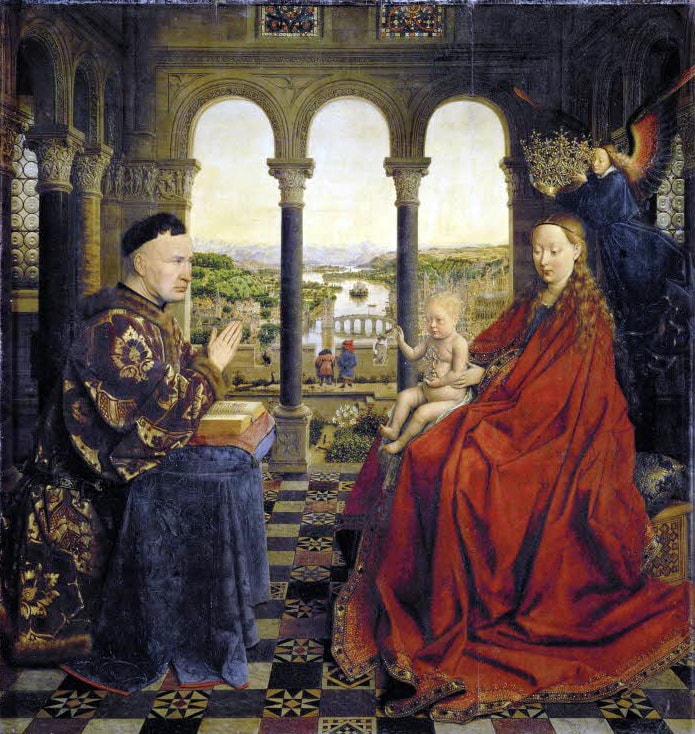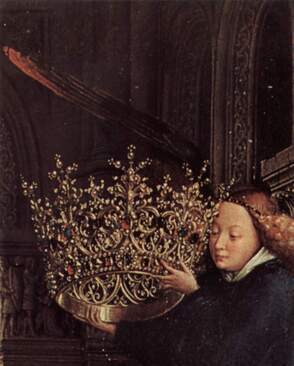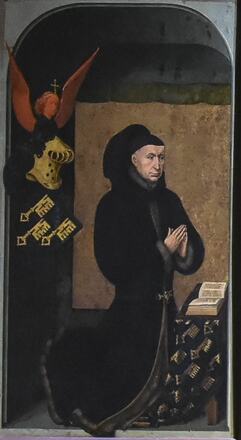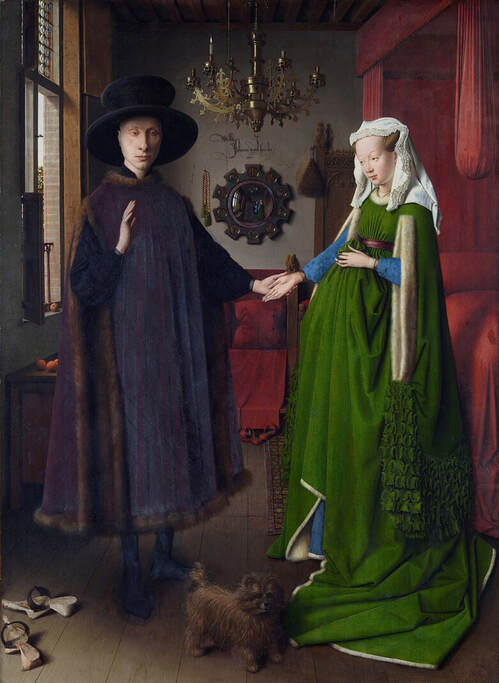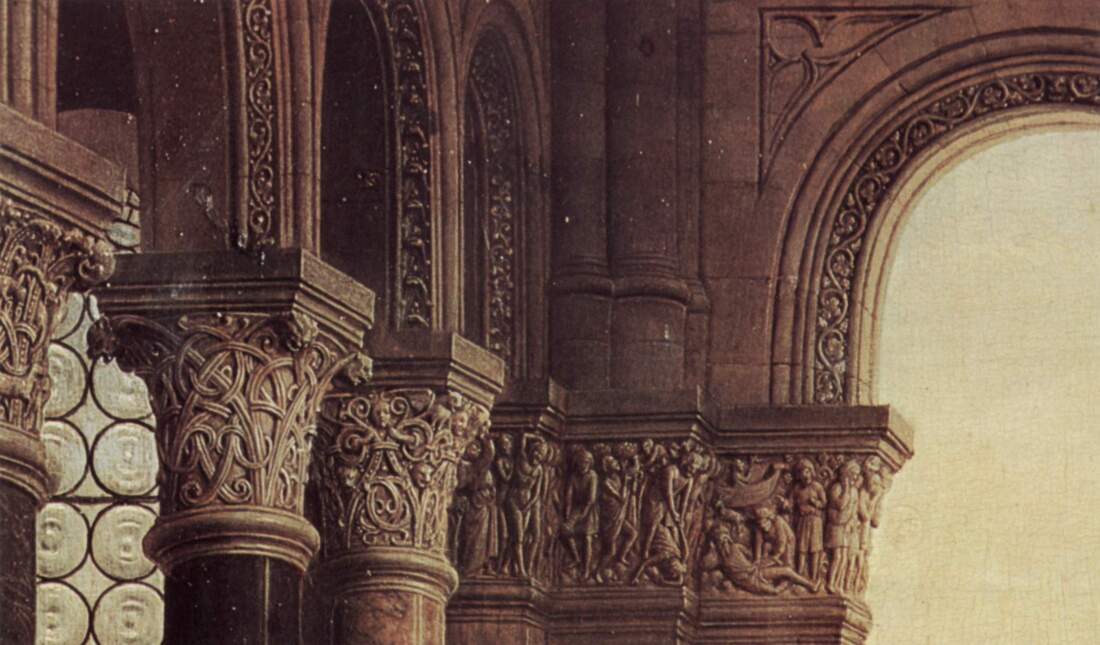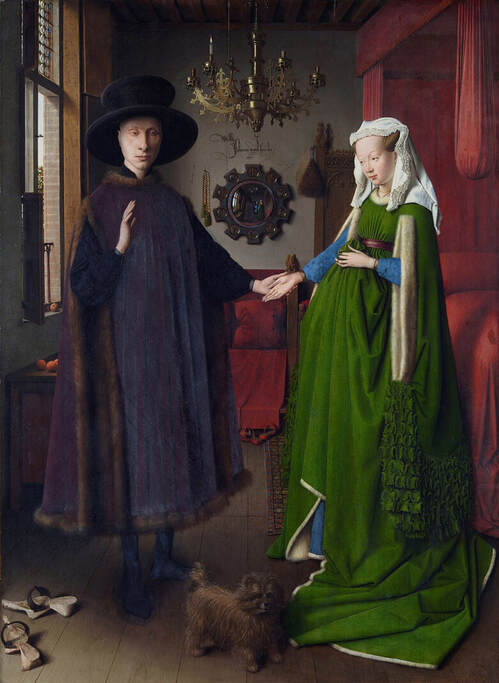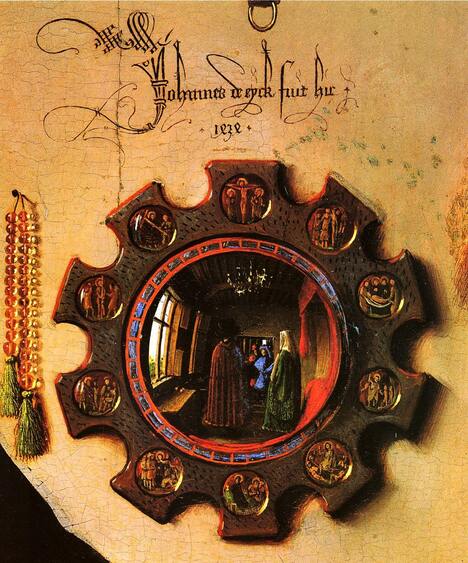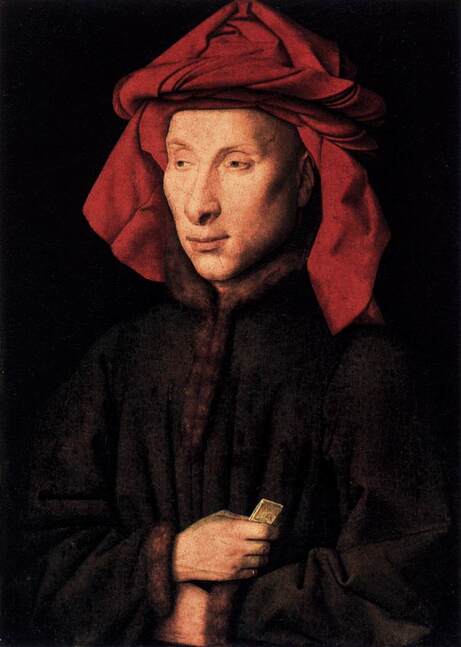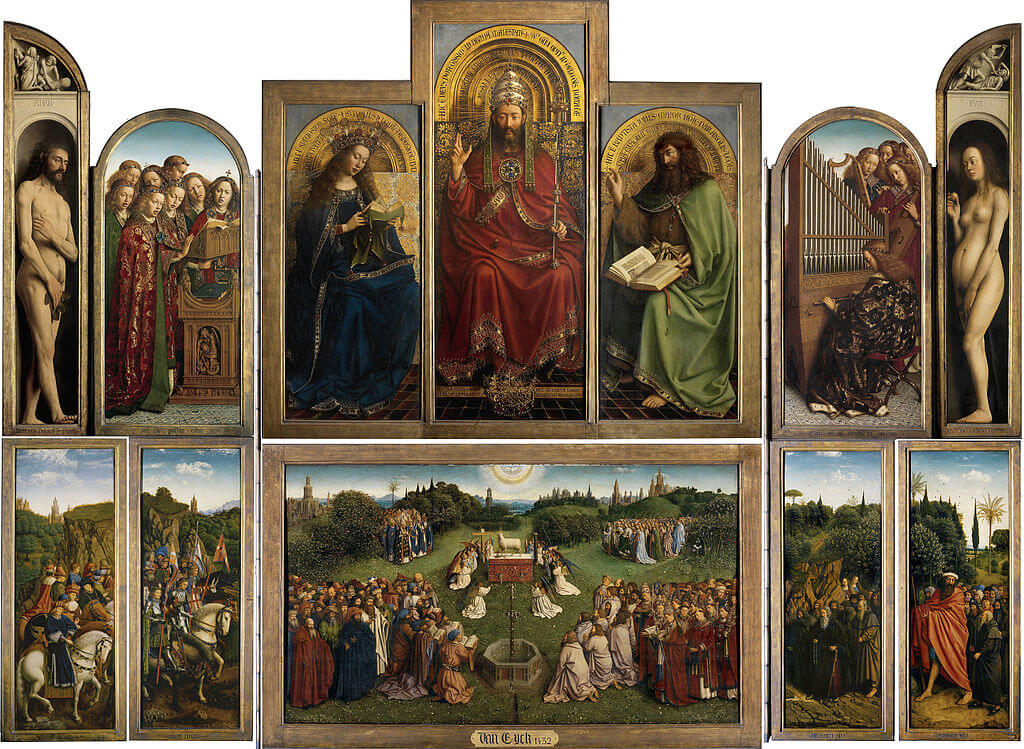|
Where? Second floor, room 818 of the Richelieu wing in the Louvre
When? Between 1435 and 1440 Commissioned by? Nicolas Rolin, the Chancellor of Burgundy under Duke Philip the Good.
What do you see? Nicolas Rolin kneels down in front of the Virgin Mary who is holding Baby Jesus. Rolin's hands are folded in prayer, and he has an open book on his lap. He does not seem to look at Mary and Jesus. Mary wears a red gown with jewelry in it and looks down with humility. Baby Jesus has his right hand raised to bless Rolin and holds an orb with a cross (called a globus cruciger) in his left hand.
In the background, you can see a city on the left, a river and bridge in the middle, and several church towers on the right, above the head of Jesus.
Backstory: This painting is also known as The Virgin with Chancellor Rolin or The Virgin of Chancellor Rolin. The painting entered the collection of the Louvre in 1805. Nicolas Rolin commissioned this painting for the Saint Sebastian chapel (the Rolin family chapel) in the Notre-Dame-du-Châtel church in Autun, near Dijon in France. This was the church that Rolin visited when he grew up and where his ancestors were buried. Rolin was the main patron of this church, and there was even an elevated walkway from his house to the church such that he could enter it at any time. Symbolism: The cross that Jesus holds in his left hand reminds the viewers that Jesus died for the sins of mankind. The three arches in the middle background represent the Holy Trinity, God, Jesus, and the Holy Spirit. The peacocks are a symbol of immortality. The flowers in the middle symbolize different virtues of Mary. Behind the praying hands of Rolin is a church tower to symbolize his faith. The church towers behind Jesus signify him as the center of the Church. The bridge in the background unites the common people and the Church. Some people have identified the city in the background as the New Jerusalem, but others are not so sure about this interpretation.
Who is Van Eyck? Jan van Eyck was born around 1390 in Maaseik, Belgium, and died in 1441. He is one of the most important representatives of the Northern Renaissance. Until 1429, he was a court painter of Duke Philip the Good, which explains why he was asked for this painting. During this time, he undertook several diplomatic missions across Europe for the Duke. Among other countries, he visited Italy, where he could learn from the innovative Italian painters.
Van Eyck was ahead of his time by using a realistic and naturalistic style in his work. This was, in part, possible because he was one of the first painters who used oil paint. He has had a big influence on future artists, including Sandro Botticelli. One of his most famous works hangs in the National Gallery in London and is The Arnolfini Portrait, which was probably painted a year before the Madonna of Chancellor Rolin.
Fun fact: The capital above the head of Rolin contains some very interesting details. It contains the following scenes:
However, Van Eyck seems to have freely interpreted these Biblical stories as he has altered some details. For example, to the right of Noah, four men are depicted. These men should represent the sons of Noah. However, Noah only had three sons. It seems likely that Van Eyck has altered these scenes to draw some parallels with Rolin’s life. Rolin, for example, had four sons and each of the ‘sons of Noah’ seem to represent the different roles of the sons of Rolin. Interested in a copy for yourself? Poster or canvas.
0 Comments
Where? Room 56 of the National Gallery
When? 1434 Commissioned by? Possibly Giovanni di Nicolao Arnolfini, an Italian merchant living in Bruges, as a memory of his deceased wife. What do you see? On the right is a woman in a green dress. On the left is a man with a big hat who raises his hand to the woman. The couple is holding hands. It is believed that this is their wedding day and they are dressed in expensive silk and fur. A small dog is standing in front of them. At first, it looks like the bride is pregnant, but this is not the case. When you look carefully, she pulls up her dress merely to indicate her desire for children. In between the couple, you can see a small part of an expensive Oriental rug. In the mirror, we can see two other people that entered the room. The mirror is surrounded by ten small paintings of the passion of Christ. Below the mirror is the signature of Van Eyck which reads: ‘Johannes de Eyck fuit hic 1434’, which means ‘Jan van Eyck was here, 1434’. This signature may suggest that Van Eyck is one of the people we can see in the mirror. To the left of the mirror hang, so-called, prayer beads of crystal. Above the couple is a chandelier with candles. Only one of the candles above the groom is lit. The couple has both taken off their shoes. The white with black shoes of the man are in the left foreground and under the red bench is a pair of red shoes from the woman. On top of the bed is a wood carving of Saint Margaret with a dragon at her feet. To the left of this carving hangs a hand brush. On the left of the painting are four oranges and outside you can see a small part of a cherry tree.
Backstory: This painting is known by several alternative names, such as The Arnolfini Double Portrait, The Arnolfini Marriage, and The Arnolfini Wedding.
The painting probably depicts Giovanni di Nicolao Arnolfini and his wife Giovanna Cenami on their wedding day, and the painting serves as a kind of marriage certificate. Giovanni was a rich Italian merchant from an influential family in Lucca in Italy. At the time of this painting, he was living in Bruges, which was an important trading city. He probably remained there for the rest of his life. This painting not only celebrates their marriage but is also a way to show off the valuable possessions of the couple. Around 1438, Van Eyck created another portrait of Giovanni, which is now in the Gemäldegalerie in Berlin.
Symbolism: This painting is full of symbolism. The couple holding hands represents the unity of the couple through marriage. The prayer beads are a gift from the groom and represent purity in the marriage. The couple has both taken off their shoes indicating that this is a sacred place.
Standing with bare feet also represents fertility. The green dress of the woman also represents fertility. The carving of Saint Margaret symbolizes her role as the patron of childbirth. The bulge in the dress of the woman indicates her desire for children. She is standing in front of the bed, which further emphasizes this desire and shows her role in the marriage. The man is standing near an open window symbolizing his role in the outside world. The red color of the bed and the bench represent passion. The dog represents fidelity. The hand brush represents the role of the woman as a housewife. The oranges are also referred to as Adam’s apples and represent the forbidden fruit that Adam and Eve ate in the paradise. They should remind the couple not to fall prey to the sin of lust. Only a single candle above the man on the chandelier is lit. The candle above the bride is not lit anymore (you can still see the leftovers of a burnt candle) and may refer to the fact that she died already. If Giovanni di Nicola Arnolfini is indeed the commissioner of this painting, his wife died in the year before the creation of the painting. The lit candle also represents the eye of God who can see everything. Who is Van Eyck? Jan van Eyck was born between 1380 and 1390 in Belgium and died in 1441. He was well educated and active in Belgium, France, and The Netherlands. He was a court painter, but also took private commissions of which most were portraits. In addition, he served as a diplomat for the government. Jan van Eyck is considered one of the most important painters of the Northern Renaissance. He has created both religious and nonreligious works which was fairly rare during his time. He was one of the first painters to sign his paintings and one of the first to use oil paint instead of the tempera method which was common during his time. Van Eyck had a big influence on many future Flemish and Dutch painters, including Johannes Vermeer. His most famous work is the Ghent Altarpiece in the St. Bavo's Cathedral. He created this piece together with his brother Hubert van Eyck.
Fun fact: It is hard to believe that during the time of this painting, couples could marry without the presence of a priest or any witnesses. In this painting, the couple gets married in a domestic setting, and only the presence of a notary was required. This is surprising given the important role of the church in society during that time.
Only since the Council of Trent, between 1545 and 1563, it was required that a priest and two witnesses needed to be present for the marriage to be valid. The presence of witnesses is still a requirement for weddings in a large part of the world. Interested in a copy for yourself? Poster of canvas (Amazon links). |
Categories
All
|
- Home
- Blog
-
Museums
- Alte Pinakothek
- Art Institute of Chicago
- Baltimore Museum of Art
- Barber Institute of Fine Arts
- Bargello
- Barnes Foundation
- British Museum
- Church of Sant’Anastasia
- Cleveland Museum of Art
- Courtauld Institute of Art
- Detroit Institute of Arts
- Frans Hals Museum
- Galleria Borghese
- Gallerie dell'Accademia
- Getty Museum
- Guggenheim
- Hermitage Museum
- Kunsthistorisches Museum
- Kunstmuseum Basel
- Legion of Honor Museum
- Louvre
- Mauritshuis
- Metropolitan Museum of Art
- Musee d’Orsay
- Museum of Fine Arts in Boston
- Museum of Modern Art
- National Gallery in London
- National Gallery of Art
- National Museum in Poznań
- Norton Simon Museum
- Ny Carlsberg Glyptotek
- Palace of Versailles
- Palazzo Pitti
- Palazzo Vecchio
- Petit Palais
- Philadelphia Museum of Art
- Prado
- Pushkin Museum
- Ravenna Art Museum
- Rijksmuseum
- San Diego Museum of Art
- Santa Maria delle Grazie
- St. Peter's Basilica
- Städel Museum
- Statens Museum for Kunst
- Tate Britain
- Tate Modern
- Timken Museum of Art
- Uffizi
- Vatican Museums
- Wallace Collection
-
Artists
- Altdorfer
- Anguissola
- Berlin Painter
- Bosch
- Botticelli
- Boucher
- Bronzino
- Bruegel the Elder
- Brunelleschi
- Cabanel
- Caillebotte
- Canova
- Caravaggio
- Carpeaux
- Cezanne
- Cimabue
- David
- Degas
- Delacroix
- De Maria
- Donatello
- El Greco
- Fontana
- Fra Angelico
- Fragonard
- Gauguin
- Gentileschi
- Gericault
- Gonzalez-Torres
- Goya
- Hals
- Hogarth
- Hokusai
- Ingres
- Leonardo da Vinci
- Lippi, Filippo
- Longhi, Barbara
- Lorrain
- Makovsky
- Manet
- Massys
- Matisse
- Merian
- Michelangelo
- Mochi
- Modigliani
- Monet
- Panini
- Parmigianino
- Perugino
- Picasso
- Pisanello
- Raphael
- Rembrandt
- Renoir
- Reynolds
- Rivera
- Rodin
- Rubens
- Scultori
- Seurat
- Steen
- Tintoretto
- Titian
- Toulouse-Lautrec
- Turner
- Uccello
- Van der Weyden
- Van Dyck
- Van Eyck
- Van Gogh
- Van Hemessen
- Vasari
- Velazquez
- Vermeer
- Veronese
- Vigée Le Brun
-
Locations
- Books
- About Us

